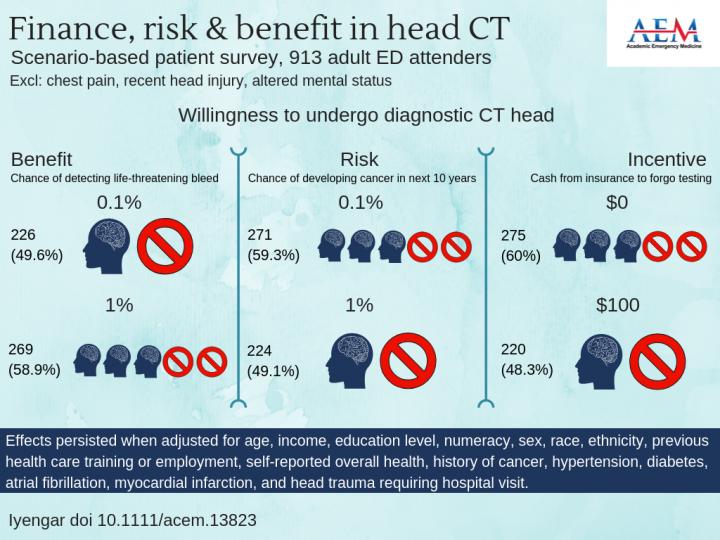
Credit: KIRSTY CHALLEN, B.SC., MBCHB, MRES, PH.D., LANCASHIRE TEACHING HOSPITALS, UNITED KINGDOM
DES PLAINES, IL — Providing financial incentives to forego testing significantly decreases patient preference for testing, even when accounting for test benefit and risk. That is the finding of a study published in the October 2019 issue of Academic Emergency Medicine (AEM), a journal of the Society for Academic Emergency Medicine (SAEM).
The lead author of the study is Rahul Iyengar MD, a resident physician at Aurora St. Luke’s Medical Center, Milwaukee, WI.
The study explores the hypothesis that patient preferences for diagnostic testing will vary substantially when the patient is presented with different quantitative information about risk, benefit and cost.
This single center survey indicated that patient “acceptance rate” for computerized tomographic (CT) imaging of the head varied substantially, even if the assumed risk and benefit of the test were varied only slightly: either 0.1 or 1%. This work supports the hypothesis that discussing benefits and risks of low-value diagnostic testing via head CT scan with patients, even when absolute benefit or risk is very low, may impact patients’ decision-making and can be the scientific cornerstone of a shared decision-making model to reduce low value diagnostic testing
Further, providing financial incentives to forego testing significantly decreased patient preference for testing, even when accounting for test benefit and risk, suggesting that implementation of a cash incentive to forego unnecessary diagnostic testing may further prove to be a successful method to decrease healthcare costs for ED patients.
The authors suggest that further study of the impact of financial incentives on patient decision making across other clinical scenarios and in nonhypothetical patient situations is needed.
Commenting on the study is Jesse Pines, MD, the National Director of Clinical Innovation at US Acute Care Solutions and a professor of emergency Medicine at Drexel University. Dr. Pines works clinically in the emergency department at Allegheny General Hospital and Adventist Shady Grove Medical Center.
“This study was hypothetical in nature, but found financial incentives to patients to forego testing for head CT in low-risk scenarios lowered the likelihood they would choose to pursue testing, a preference that persisted even at different likelihoods of benefit and risk from the test. This demonstrates that patient preferences for ED care decisions may be influenced by financial considerations such as out-of-pocket costs — particularly in the case of using expensive tests like CT to find rare but important clinical findings. This work is important and deserves further study as increasingly patients are required to pay for care out-of-pocket in the United States.”
###
ABOUT ACADEMIC EMERGENCY MEDICINE
Academic Emergency Medicine, the monthly journal of Society for Academic Emergency Medicine, features the best in peer-reviewed, cutting-edge original research relevant to the practice and investigation of emergency care. The above study is published open access and can be downloaded by following the DOI link: https:/
ABOUT THE SOCIETY FOR ACADEMIC EMERGENCY MEDICINE
SAEM is a 501(c)(3) not-for-profit organization dedicated to the improvement of care of the acutely ill and injured patient by leading the advancement of academic emergency medicine through education and research, advocacy, and professional development. To learn more, visit saem.org.
Media Contact
Stacey Roseen
[email protected]
708-606-7120
Related Journal Article
http://dx.




